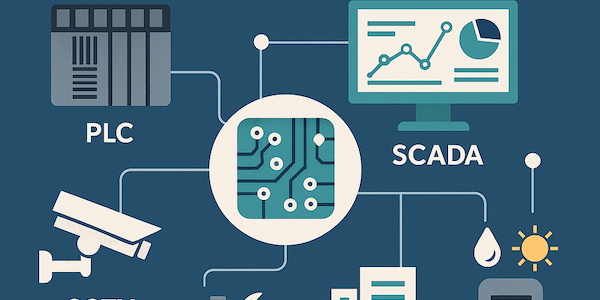As more Mechanical & Electrical (M&E) vendors take on projects involving Operational Technology (OT) in critical infrastructure — from defense facilities to surveillance networks — cybersecurity is no longer optional. It’s a fundamental requirement.
Whether you’re deploying SCADA systems for water treatment or installing sensors in a defense facility, your OT systems are now part of the national digital perimeter. A single weak point can become a doorway for threat actors — and that’s not just a theoretical risk.
The UNC3886 Wake-Up Call
In one of the most alarming cyber-espionage campaigns in recent years, UNC3886, a sophisticated threat group, targeted defense and critical infrastructure systems via OT and hypervisor backdoors. They exploited secure but unmonitored environments, leveraging out-of-band access and zero-day vulnerabilities to stay hidden — bypassing traditional IT security.
The UNC3886 case highlighted a terrifying reality: OT systems, often assumed to be “offline” or “safe,” are now prime targets. And once breached, attackers can manipulate physical environments without ever touching traditional networks.
Far from being a one-off, this incident signals a broader trend. In response, Singapore authorities are tightening cybersecurity regulations, requiring OT systems to meet strict security standards before deployment in government projects.
What Is OT (Operational Technology)?
Operational Technology (OT) refers to the hardware and software systems that monitor and control physical devices, processes, and infrastructure.
Examples include:
-
Programmable Logic Controllers (PLCs)
-
Supervisory Control and Data Acquisition (SCADA) systems
-
Building Management Systems (BMS)
-
Sensors, actuators, and CCTV systems
-
Power distribution units, HVAC systems, and access control systems
Unlike IT systems that manage data and communications, OT systems control real-world outcomes — turning on pumps, opening gates, regulating power flow, and more.
Typical OT Targets in M&E Deployments
As an M&E vendor, you may be responsible for OT components such as:
-
Fire alarm and suppression systems
-
Electrical control panels and switchboards
-
Surveillance and monitoring infrastructure
-
Environment monitoring (e.g., temperature, humidity, vibration sensors)
-
Smart lighting and energy management systems
When these systems are deployed in government or critical infrastructure, they become attractive targets for nation-state actors and cybercriminals. Their goal? Not to steal data — but to disrupt or manipulate physical operations.
Why Cybersecurity in OT Is So Critical
Traditional IT systems were designed with security in mind. OT systems were not. Many still run on outdated platforms or use default credentials. Worse, they are often assumed to be “air-gapped” — even when they’re not.
One key difference between IT and OT environments lies in security priorities.
In IT, the focus is on Confidentiality, Integrity and Availability (CIA) — protecting data from unauthorized access or tampering.
In OT, the priorities are flipped to Availability, Integrity and Confidentiality (AIC) — because keeping systems running safely is paramount, even over data protection.
Key Cybersecurity Concerns in OT:
-
Availability: Downtime can cause real-world failures (e.g., water plant shutdown, HVAC disruption).
-
Integrity: Manipulated sensors or controllers can feed false data and lead to dangerous outcomes.
-
Limited Visibility: Many OT devices are “black boxes” with little or no logging or monitoring capabilities.
-
Insecure Protocols: Widely used OT protocols like Modbus, BACnet, and DNP3 often lack encryption or authentication.
As attacks like UNC3886 have shown, invisibility doesn’t mean immunity. Sophisticated threat actors are already probing for blind spots — and OT environments full of legacy systems and flat networks are high-value targets.
What M&E Vendors Must Do
To meet rising expectations from agencies like Singapore’s CSA, M&E vendors need to:
✅ Understand What You’re Connecting
Identify systems with internet access or interconnection to corporate networks. Even a smart thermostat could be an entry point.
✅ Conduct Vulnerability Assessments
Perform OT-specific VAPT before go-live.
✅ Segment the Network
Use firewalls or VLANs to isolate OT from IT and external networks.
✅ Use Strong Access Controls
Replace factory-default passwords. Implement role-based access control (RBAC) and multi-factor authentication for remote access.
✅ Document and Patch
Maintain an asset inventory, document software versions, and apply patches during maintenance windows.
Future OT Trends to Watch (and Prepare For)
-
Convergence of IT and OT Networks
Smart building and IoT dashboards are linking previously siloed systems — increasing exposure. -
AI and Predictive Maintenance
New algorithms introduce new attack surfaces. Integrity of AI models must be protected. -
Remote Access and Monitoring
Growing need for encrypted connections, VPNs and MFA — no more “convenient but unprotected” access. -
Stricter Government Oversight
Compliance is becoming mandatory, especially in Singapore’s public sector.
Final Thoughts
As an M&E vendor working on government or critical infrastructure projects, your role now spans beyond physical installation. You’re part of the cyber defense chain — and need to act like it.
Attackers like UNC3886 have proven they’re targeting the OT layer. The good news? By embracing security-by-design practices now, you’re not only protecting your clients — you’re future-proofing your business.
~ ~ ~ ~ ~ ~ ~ ~ ~ ~ ~
Need help with OT security testing or compliance?
We provide penetration testing, security assessments and guidance tailored for M&E vendors working in regulated environments.
Checkout here for more details.








